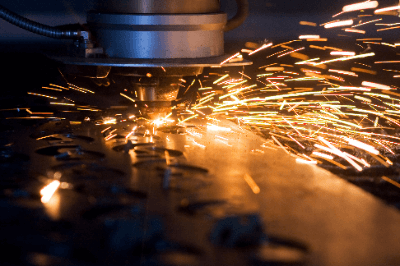What Is a Cutting Machine?
 A cutting machine is a general term for machines used for cutting, cutting, and drilling workpieces.
A cutting machine is a general term for machines used for cutting, cutting, and drilling workpieces.
Since there are many methods of cutting, it is necessary to select the appropriate method for each shape to be machined. The direction, number, and shape of tool blades also vary.
Uses of Cutting Machines
Cutting machines are used to produce parts in a wide range of fields, from everyday applications such as screws and plumbing components to industrial machinery, medical equipment, and robots. While the use of dies and molds is one method for mass-producing parts of the same shape, cutting machines are suitable for producing parts of complex shapes in small lots to meet diversifying needs.
Principles of Cutting Machines
The principles of cutting machines can be broadly classified into two categories: turning, in which the workpiece is rotated, and the tool is applied to it to create the workpiece. The other is turning, in which the workpiece is fixed and the tool is rotated.
1. Turning
Turning is a machining method similar to shaping ceramics with a potter’s wheel. A typical cutting machine is a lathe. By rotating a disk or cylindrical workpiece and applying a tool on a blade fixed to the spindle, it is possible to perform external rounding, face milling, drilling, boring, and threading on the surface.
On a general-purpose lathe, the operator manually feeds the workpiece and operates the tools. NC stands for numerical control, which allows the operator to program the coordinates of tool operation and the number of revolutions of the workpiece, etc., so that quality is stable regardless of the operator’s skill level, and mass production of workpieces of the same shape is possible. This ensures stable quality regardless of the operator’s skill level and enables mass production of workpieces with the same shape.
2. Rolling
Rolling is a method of shaping a workpiece by applying a cutting tool with a blade while rotating it. Typical milling machines are milling machines. Milling machines use various types of cutting tools, such as end mills, face milling machines, and groove milling machines. They are characterized by their ability to machine grooves and curves.
Like lathes, general-purpose milling machines operate tools manually, and operators set machining conditions, such as tool position and depth of cut, based on their own judgment. On the other hand, computer-controlled NC milling machines are capable of machining more complex shapes than general-purpose milling machines, controlled by machining programs using design software such as 3D CAD.
There are also machining centers, in which separate tools can be mounted on multiple axes that combine linear and rotational motion to perform cutting such as drilling and curved surface machining continuously, enabling the machining of complex shapes.
Types of Cutting Machines
The appropriate cutting machine must be selected according to the desired shape. There are three main types: turning, milling, and drilling.
1. Turning
Turning is a processing method in which a material such as metal is rotated and a tool on a blade is applied to it to cut it into a cylindrical shape. Among the various machining methods, the feature of rotating the workpiece makes it possible to produce round-shaped products such as needles and bolts.
2. Milling
Milling is a machining method in which the workpiece is fixed and a multi-bladed tool called a milling cutter is rotated and applied to the workpiece. Milling is similar in shape to drilling, but differs in that the blades are provided on the sides. There are a wide variety of milling tools, so the most suitable one is selected depending on the machining process. The milling machine can be used for curved surface processing and grooving.
3. Drilling
Hole drilling is a method in which the workpiece is held in place and a rotating drill is applied to the workpiece to cut and penetrate it. Because drilling on a smooth surface can cause misalignment, a center hole is first made and then the hole is drilled.
When drilling holes that require high precision, such as in automobile and aircraft parts, a blade with a blade on the side called a reamer is used. Applications for drilling include screws and bolts.
Other Information on Cutting Machines
1. Advantages of Cutting Machines
The advantage of cutting machines is that they can process complex shapes and with high precision. Computer-controlled cutting machines such as NC lathes, NC milling machines, and machining centers can be used to mass-produce products with minimal variation.
Cutting machines that perform processing by hand, such as general-purpose lathes and general-purpose milling machines, allow complex processing in small-lot production.
2. Disadvantages of Cutting Machines
The disadvantage of cutting machines is that they always produce cutting debris. Also, depending on the material, the heat generated during cutting may cause deformation or reduce machining accuracy, so appropriate machining speed settings are required.
In addition, because heat is generated during cutting, cutting oil must be used more frequently and cutting tools must be replaced due to wear.